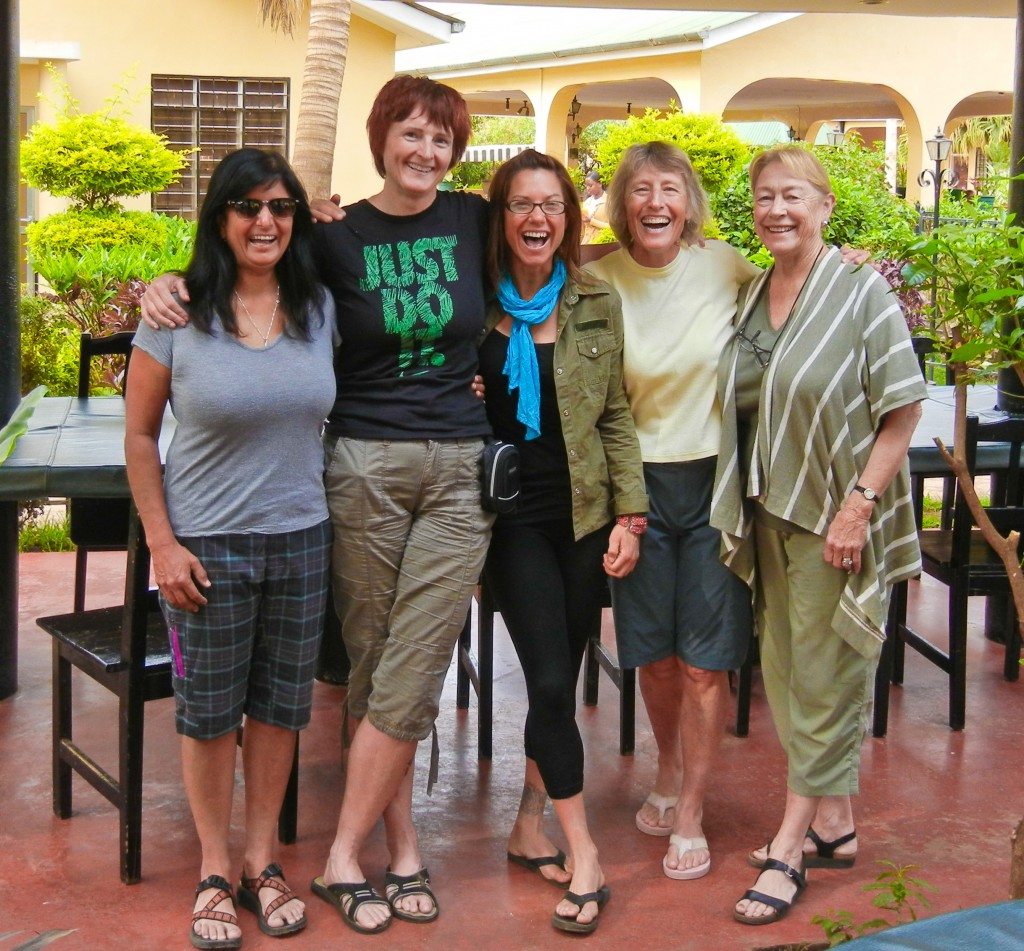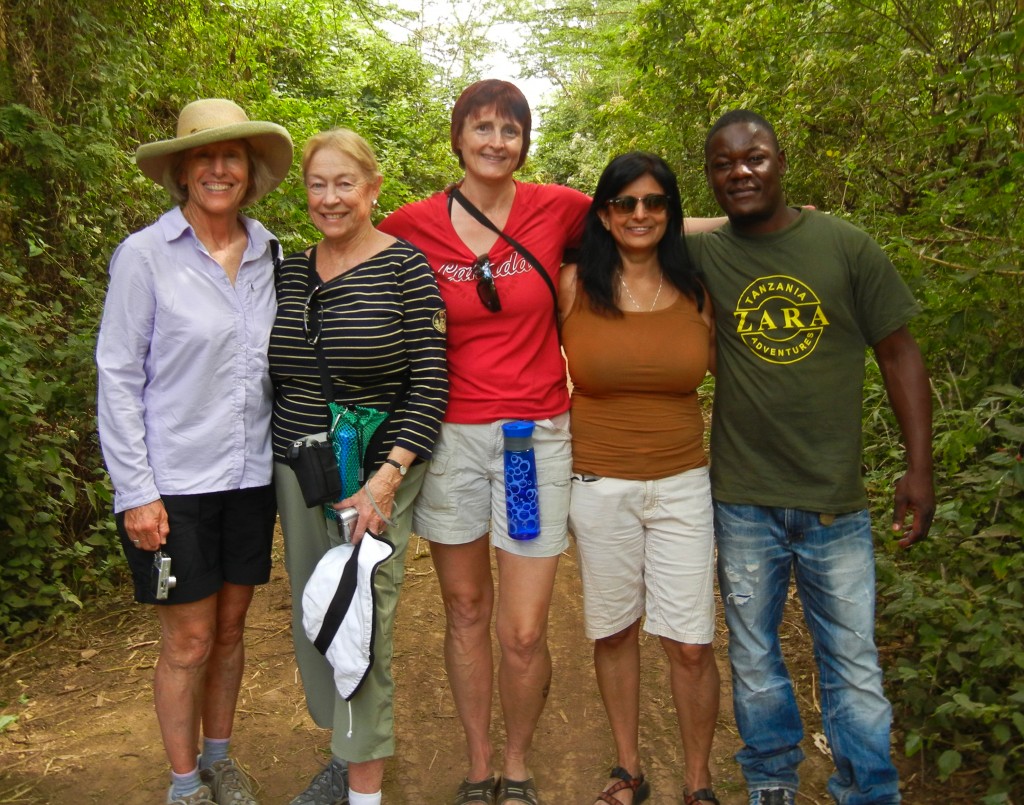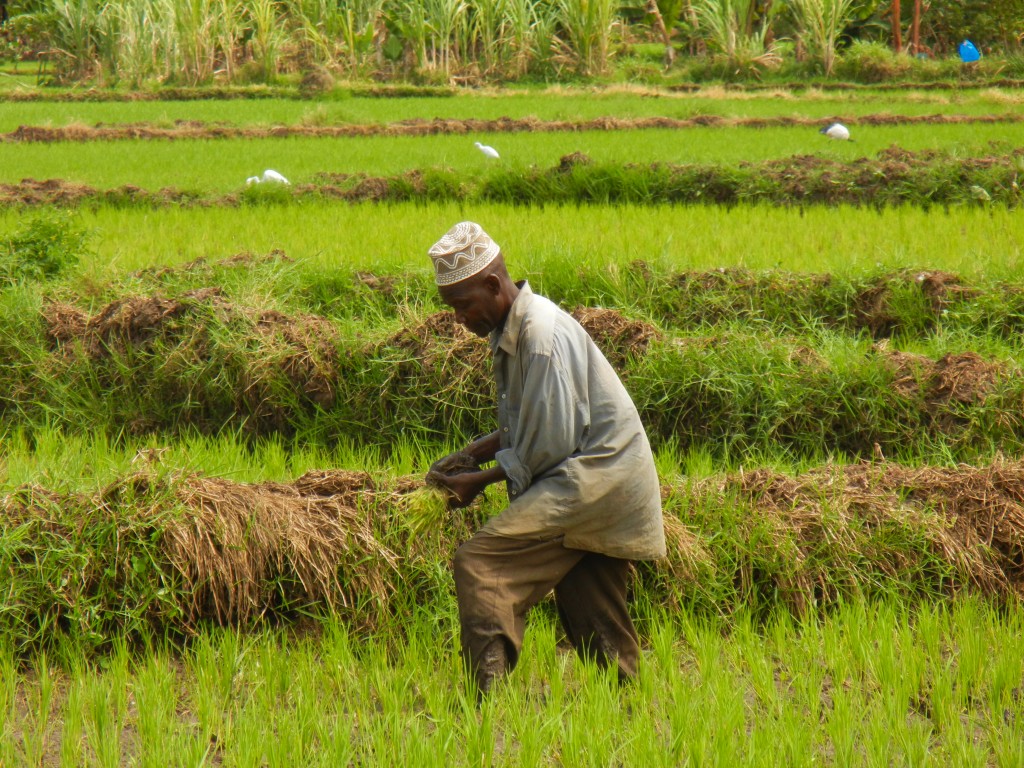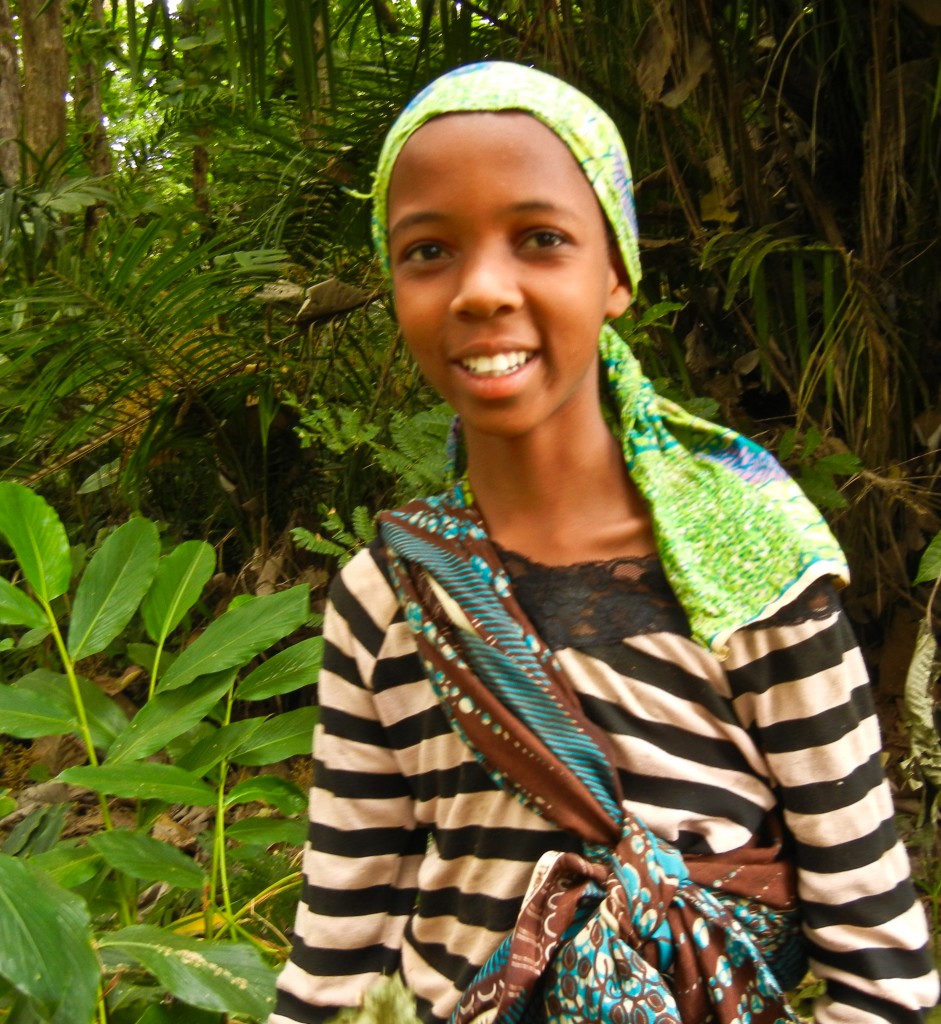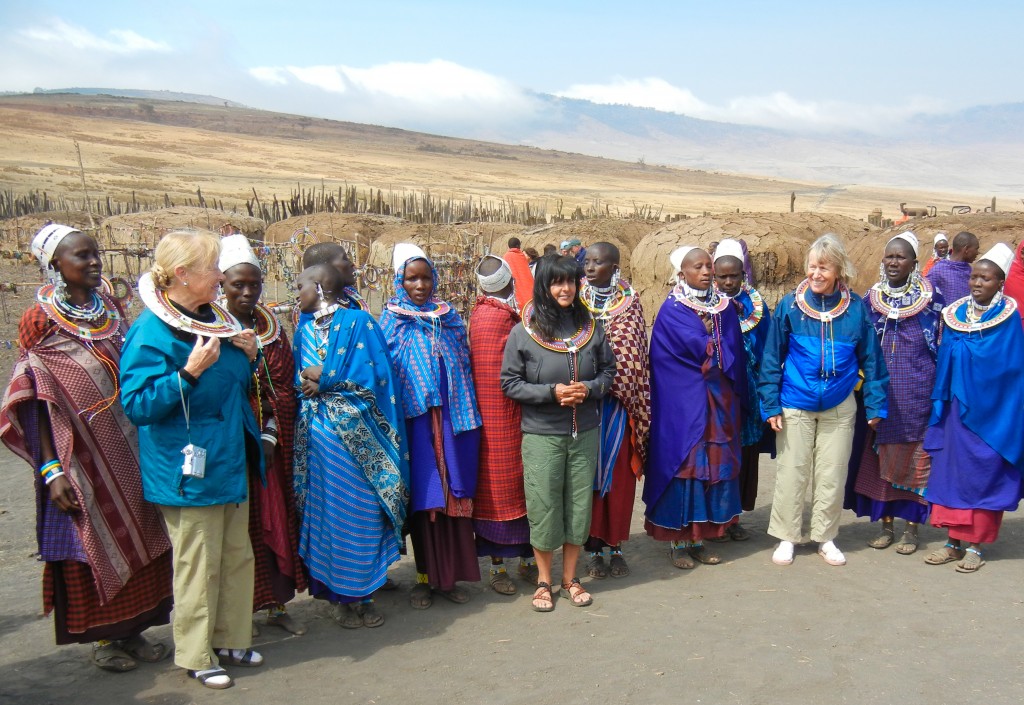
September 23, 2012: Summit photo on Carstensz Pyramid (4884m/16,024'). From left to right: Esther Kim, Vanessa O'Brien, Andrea Cordona, and SMI founder Kurt Wedberg.
SMI founder Kurt Wedberg just returned from Indonesia where he guided a climb of Carstensz Pyramid (4484m/16,024’). This is a write up of the trip as told by Kurt…
On September 15 I boarded a China Airlines flight at LAX bound for Jakarta, Indonesia. I was meeting three ambitious ladies who intended to climb Carstensz Pyramid located deep in the jungle on the island of Papua. Carstensz gained notoriety in the international mountaineering community in the 1980s when climbers started including it as one of the coveted “Seven Summits”; the highest mountain on each continent. Carstensz Pyramid is the highest mountain on the Oceana continent. Previously this continent was limited to Australia making the highest peak on this continent Mt. Kosciuszko (2228m/7310′).

Carstensz Pyramid (4884m/16,024') located on the island of Papua, Indonesia.
Access to Carstensz Pyramid is one of the biggest hurdles to climbing it. The island of Papua is still inhabited by several native tribes who see very little contact with people from the outside world. Two of the biggest tribes are the Dani and Moni. Since we would be traveling on their land permission needed to be granted for us to walk through their territory. We also needed their help with hiring porters to carry our gear, fuel, and supplies for 12 days in the jungle.

Kurt Wedberg with a Moni tribe elder in the town of Sugapa, Papua Indonesia.

Some of our porters from the Moni tribe in Papua.
Our team met in Jakarta on September 16 where we organized our equipment. We then flew overnight to Timika on the island of Papua. The weather was hot and humid in this town located a short distance from the coast. From Timika we took a charter flight to the village of Sugapa. Here the weather was slightly cooler but the equatorial sun was piercing and bright. At Sugapa we arranged for Moni tribe members to porter our loads and prepared to start walking. We would be trekking past the historical boundaries of the Moni territory and it was important that we had them with us. The trailhead was accessed by riding on the backs of motorcycles along a dirt road for 20+ minutes.

The village of Sugapa and the runway located deep in the jungle on the island of Papua. Airplanes are their only connection to the outside world.

Moni tribe members discussing our route through the jungle and the porter loads they would carry during our trek to Carstensz Pyramid.

Esther and Vanessa on the backs of motorcycles that will take us to the start of our route. It was about a 15 minutes motorcycle ride over a dirt road.
On September 17 we began our trek. Over the next 5 ½ days we planned to hike 100km/62 miles to reach Carstensz Pyramid. On Day 1 we passed by several Moni villages. It rained hard at times and we quickly learned that two of our most important pieces of equipment we brought were our thick rubber Hunter boots to trample through the mud and an umbrella. We stayed in the furthest village along this path at 1991m/6532’. From here the trail became less defined. On September 18 we traversed a hillside to a large river that we paralleled for most of the 7 hours of walking. The terrain varied from solid rock to thick mud. Rain returned after lunch and made our path significantly muddier plus rocks and tree roots became more slippery. Even with high top boots our pants got caked with mud. Our camp was pitched at 2276m/7467’ in a small clearing amid thick jungle foliage next to a large roaring river. Nearby was a creek of clear running water that provided a nice place to wash our pants and boots. Even after these first two days it became obvious that trekking through the jungle would be hard work. Every single step requires thought and effort. Relaxing mentally even for one step is recipe for losing footing on the muddy wet slippery terrain.

Andrea, Esther, and Vanessa traversing a muddy slope on September 18, day 1 of the trek.

A fence made of local wood along our trekking route in a Moni tribe village.

Huts in a Moni tribe village.

Moni tribe members discussing our route for day 2, September 18.

Muddy boots on September 18.

One of many log crossings over a river.

Our camp in the jungle on September 18. At each camp we draped a tarp over a wooden frame to give us a dry place to cook and eat meals, plus give us a place to hang out away from the rain.
On September 19 our goal was to get high enough to reach the top end of the thick jungle environment and start entering a large plateau. Our porters had a camp in mind that offered a good water source and flat terrain for camping. The path continued to deteriorate throughout the day. The footing became more slippery, the mud became thicker, and we found ourselves grabbing mossy tree branches to surmount steeper sections of the route. In the middle of the route we passed a small “village” consisting of one hut and a family. They were friendly and let us sit on the grass outside their hut and each lunch. Weather remained warm and humid. The clothing of choice was long pants and long sleeves for abrasion protection from plants but clothing that would offer breathability to prevent overheating. I wore a pair of loose fitting and comfortable Patagonia pants and a wool Icebreaker short sleeve shirt. I was the only team member who chose a short sleeve shirt. I managed to keep my arms from getting scratched too much but the other three were happy to have worn long sleeves. I was truly impressed with how well wool garments performed here. The insulating properties of wool allow it to have a much wider temperature range than any synthetic material I’ve ever used. In my pack I kept two heavier Icebreaker wool layers in case I needed arm protection and additional warmth. The day wore on and by late afternoon it became apparent we were running out of water and no camp was in site. Soon after our water ran out we also started losing our daylight. We found our pace slowed in the darkness in spite of us donning headlamps. We kept walking following our porters path finally reaching our intended camp at 3222m/10,570’ in the dark after 10 ½ hours of walking. Tired and dehydrated we counted it a big blessing we were relieved of dealing with rainy weather while hiking today.

Our porters crossing a large river. these log crossings were numerous in the jungle. Our bare footed porters moved with ease over these wet slick logs. A fall off this log would have sent anybody into the swift fast current below with a water level several feet high.

Andrea crossing a bridge made from small and medium size branches held together by vines wrapped around small branches laid in cross sections at intervals along the bridge.

Close up photo of vines and cross sections that hold the bridges branches together.

A moni tribe member using a machete to clear jungle foliage to aid in hunting.

A Moni family and their hut in the middle of the jungle. With great amusement they teach Kurt how to use their hand made bow and arrow they use to hunt.

Negotiating the terrain in the jungle.

The team pauses for a photo during a rare sunny morning on the plateau above the jungle. The team hiked for two days over this plateau reaching an elevation as high as 3808m/12,493'.

A typical day of rain on the trail. It rained every day of this trip and with the exception of a couple days it rained during our walk. An umbrella was an invaluable piece of gear for this trip.
We woke on September 20 after a good night of welcomed rest and rehydration. We’re now half way to our Base Camp for Carstensz Pyramid. Over the next three days we would gain elevation and the terrain would open up offering us views of the surrounding hillsides. We hoped this would signal an end to the mud but no such luck! Instead of mud mixed in with tree roots and slippery rocks we had mud mixed in with wet marshy patches that would deceivingly not support body weight. A misstep here could mean sinking in past the knee and water entering our boots. My socks got wet each day regardless because Hunter boots are not breathable. This is where I found my wool Icebreaker socks to be invaluable. They would dry out at night and during the day they performed well regardless of how wet they got. If our socks weren’t getting wet from inside the boots or from a misstep in the marsh they would get wet from the rain that came down heavy at times over the next three days. Since we were out of the thick foliage of the lower jungle our umbrellas were easier to manage. Arriving at camp each night with muddy boots and pants and soaked clothing we spent the late afternoons trying our best to clean up and get warm and comfortable in our tents. We put in camps at 3569m/11,709’ and 3717m/12,194’ before reaching our Base Camp on September 22 at 4330m/14,205’. Arriving at mid afternoon we had time to organize our climbing gear and prepare for our climb of Carstensz Pyramid in early morning.

Vanessa negotiating mud on September 22 en route to Base Camp.

September 22 en route to Base Camp. Heavy rain lasted most of the day. Now at higher elevation the temperature dropped from the warm tropical climate to much cooler requiring team members to wear a couple layers of clothing underneath their rain gear. We reached an elevation of 4500m/14,763'.

September 22: Kurt at the high point for the day at 4500m/14,763'. The last thing Kurt purchased for this trip was an umbrella from K-Mart in Bishop. This proved to be his favorite piece of gear!

Base Camp at 4330m/14,205'. Carstensz Pyramid, which was shrouded in clouds all day, is located out of the photo to the right on the other side of the ridgeline.
Our mountain was sitting in a cloud above us with rain soaking the route all day. Finally by evening time the rain quit and revealed stars through partially cloudy skies. Our strategy was to leave early, climb efficiently, and hopefully reach the summit by early morning. We hoped to be on the summit and descending before any precipitation began. Although it can (and did) rain at any time day or night the odds in the mountain environment usually trend towards less precipitation in the mornings and more in the afternoons. Just the same we carried our umbrellas for the one hour approach and left them at the base of the route.
The rock on Carstensz Pyramid is hard limestone. The abrasive nature of it meant it would be hard on our clothing but it also provides a lot of friction making for good hand holds and solid purchase for our feet. The rock is also not very porous and therefore doesn’t absorb water. Thus even after so much rain the rock was dry as we started up the route at 3:30am. The climbing consists of scrambling on terrain anywhere from 3rd class up to low 5th class. Fixed lines have been placed over the years on various sections and these were in varying degrees of wear. My job on this climb was to keep these ladies safe, negotiate the most effective route, and coach them on the most efficient techniques to climb. I checked the integrity of the lines and the anchors and as we got into the rhythm of moving we found the climbing to be very enjoyable. As daylight approached we found ourselves high up on Carstensz Pyramid approaching the long summit ridge we would traverse. A few 5th class moves led us to the ridge where we turned left and moved to the most exciting part of the route; a Tyrolean Traverse approximately 30m/98’ long over an airy and exposed spot on the ridge. The challenge of a Tyrolean Traverse revolves around more mental aspects than physical. They are usually wildly exposed (hence the need for employing this technique) and intimidating to trust at first but once you start on them it is just a matter of moving across the lines and before you know it you’re on the other side. I rigged everybody with two safety backup systems and we clipped into five different ropes offering plenty of redundancy and piece of mind. The remoteness of where we were was not lost on any of us!!

Vanessa feeling out her moves on a small chimney on the lower part of the route on Carstensz Pyramid.

An easier area of the climb in between 5th class sections.

Vanessa climbing a 5th class pitch directly below the summit ridge.

Esther getting close to the summit ridge.

Andrea enjoying a 5th class pitch on the route.

View of the surrounding landscape at 5:45am from high up on Carstensz Pyramid.

Esther and Andrea traversing the summit ridge below the Tyrolean Traverse.

Vanessa started the Tyrolean Traverse.

Andrea on the Tyrolean Traverse.

Esther on a small "step across" on the summit ridge.

Traversing the summit ridge of Carstensz Pyramid.

Esther and Andrea high on the summit ridge of Carstensz Pyramid.
One by one we made it across the Tyrolean Traverse then continued traversing the ridge line. A couple more impasses were encountered that required stretching across smaller expanses but with good backups and carefully placed hands and feet these posed little problems for the ladies. The terrain then got easier for the last few minutes leading to the summit. Vanessa and I found ourselves slightly ahead of the rest. I surmounted a small notch and looked up 40’ above me and realized that was the summit. I turned to Vanessa and told her to scramble on past me to the summit and she could be the first to stand on top and I’d get some pictures of her. She obliged and made the final steps towards the 5th of her Seven Summits! Shortly afterwards the others joined us on the summit. We were blessed with intermittent clouds and clear skies offering an occasional view, pleasant temperatures, and no precipitation. We exchanged summit photos and hugs and made a couple calls on our satellite phones before it was time to descend.

Vanessa on the summit. This was the 5th of her Seven Summits. She is scheduled to go to Antarctica to attempt Mt. Vinson in November and Aconcagua in Argentina in January.

Esther elated to be on the summit of Carstensz Pyramid.

Andrea poses on the summit with the Guatemalan flag. This moment completed not only her Seven Summits but also the Adventure Grand Slam which includes the North and South Poles. She is the first female from Central America to accomplish the feat. Congratulations Andrea!!

Kurt standing on the top of Carstensz Pyramid reaching the final of his Seven Summits!

Kurt calling on his satellite phone from the summit of Carstensz Pyramid. Within minutes of reaching loved ones with the news of their successful summit an announcement was posted here on this blog.

Carstensz Pyramid summit photo: Esther Kim, Vanessa O' Brien, Andrea Cordona, and Kurt Wedberg
Retracing our steps we made it across the summit ridge and started down as light snow began to fall. It was wet and melted upon touching the rock. As we descended further the rock got increasingly wet until small streams were flowing down crack systems all around us. Our gloved hands got soaked but each step brought us closer to the bottom. Many rappels and short step downs brought us to the base of the route where our trusty umbrellas awaited us. As the rain picked up in intensity we hiked back to our camp. We had snuck in a successful ascent of Carstensz Pyramid and we were happy for that. It would be another four days of trekking through mud and rain retracing our route back to Sugapa. We managed that and in the process completed an amazing adventure on a remote and distant island in an exotic land with an experience I’m sure the team will remember for the rest of our lives!
On a personal note this was a truly rewarding experience for me. As a professional mountain guide at SMI our goal is to keep our clients safe and help them achieve their intended goals. Along the way we continue to make many new and dear friends. All those missions were accomplished here. It also completed my own Seven Summits journey. It began 20 years ago in July of 1992 when I was a young assistant guide on my first expedition to Mt. McKinley (20,320’/6193m), the highest mountain on the North American continent. SMI is now positioned to guide climbs on all seven continents. I’ll share more on the journey to the Seven Summits soon.
I want to extend a big thank you to Andrea, Esther, and Vanessa for sharing such an incredible adventure on Carstensz Pyramid. I also want to thank my family and dear friends who have been so supportive of me throughout my guiding career. Finally, a special thank you to all of our clients who we continue to share so many incredibly memorable experiences with. We look forward to seeing you back and to all the new people we will meet along the way. We already have many trips lined up for the next coming year and we hope to see many of you on one soon!
The entire photo gallery from this climb can be found here: Carstensz Pyramid September 2012

